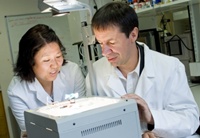Rock music bolsters solar cell efficiency
07 Nov 2013
Playing pop and rock music improves the performance of solar cells, according to new research from scientists at Queen Mary University of London and Imperial College London.
 Scientists showed that high pitched sounds like those common in pop and rock music caused the greatest improvement in the solar cells' power output, increasing it by up to forty per cent. Classical music, with typically lower pitched sounds, still increased the cells' output, but not as much.
Scientists showed that high pitched sounds like those common in pop and rock music caused the greatest improvement in the solar cells' power output, increasing it by up to forty per cent. Classical music, with typically lower pitched sounds, still increased the cells' output, but not as much.
This discovery makes it possible to power a wider range devices with solar energy than at present, as scientists can improve the efficiency of solar cells using the ambient, or background, noise present in many environments.
The study has implications for improving energy generation from sunlight, particularly for the development of new, lower cost, printed solar cells.
The researchers grew billions of tiny rods (nanorods) made from zinc oxide, then covered them with an active polymer to form a device that converts sunlight into electricity.
Using the special properties of the zinc oxide material, the team was able to show that sound levels as low as 75 decibels (equivalent to a typical roadside noise or a printer in an office) could significantly improve the solar cell performance.
"After investigating systems for converting vibrations into electricity this is a really exciting development that shows a similar set of physical properties can also enhance the performance of a photovoltaic," says Dr Steve Dunn, reader in Nanoscale Materials from Queen Mary's School of Engineering and Materials Science.
Scientists had previously shown that applying pressure or strain to zinc oxide materials could result in voltage outputs, known as the piezoelectric effect. However, the effect of these piezoelectric voltages on solar cell efficiency had not received significant attention before.
"We thought the sound waves, which produce random fluctuations, would cancel each other out and so didn't expect to see any significant overall effect on the power output," says James Durrant, Professor of Photochemistry at Imperial College London, who co-led the study.
"The key for us was that not only that the random fluctuations from the sound didn't cancel each other out, but also that some frequencies of sound seemed really to amplify the solar cell output - so that the increase in power was a remarkably big effect considering how little sound energy we put in, " Durrant adds.
"We tried playing music instead of dull flat sounds, as this helped us explore the effect of different pitches. The biggest difference we found was when we played pop music rather than classical, which we now realise is because our acoustic solar cells respond best to the higher pitched sounds present in pop music," he concludes.
The discovery could be used to power devices that are exposed to acoustic vibrations, such as air conditioning units or within cars and other vehicles.
Dr Dunn adds, "The work highlights the benefits of collaboration to develop new and interesting systems and scientific understanding."
'Acoustic enhancement of polymer / ZnO nanorod photovoltatic device performance' was published in Advanced Materials on Wednesday 6 November 2013.






























